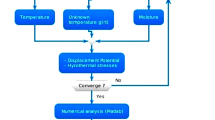Abstract
The hygrothermal performance of a construction material can be assessed by analysing energy, moisture, and air balances. The hygrothermal balances consider the normal flows of heat by conduction, convection, and radiation; moisture flows by vapour diffusion, convection, and liquid transport; and airflows driven by natural, external, or mechanical forces.
Access this chapter
Tax calculation will be finalised at checkout
Purchases are for personal use only
Similar content being viewed by others
References
ASHRAE, 160P (2009) Criteria for moisture control design analysis in buildings. ASHRAE, USA
ASTM, C 20 (2000) Test method for water absorption, bulk density, apparent porosity and apparent specific gravity of fired white ware products. ASTM International, Philadelphia
ASTM, C 351-92b (1999) Test method for mean specific heat of thermal insulation. ASTM International, Philadelphia
Blocken B (2004) Wind-driven rain on buildings—measurements, numerical modelling and applications. PhD thesis, Katholieke Universiteit Leuven, Leuven
Burch DM, Tomas W, Fanney A (1992) Water vapour permeability measurements of common building materials. ASHRAE Trans 98(Part.2):486–494
EN 12390-7 (2000) Testing hardened concrete. Density of hardened concrete. British Standards, London
EN 12524 (2000) Building materials and products—hygrothermal properties—tabulated design values. British Standards, London
EN 12664 (2001) Thermal performance of building materials and products—determination of thermal resistance by means of guarded hot plate and heat flow meter methods—dry and moist products of medium and low thermal resistance. British Standards, London
EN 12667 (2001) Thermal performance of building materials and products—determination of thermal resistance by means of guarded hot plate and heat flow meter methods—products of high and medium thermal resistance. British Standards, London
EN 12939 (2001) Thermal performance of building materials and products—determination of thermal resistance by means of guarded hot plate and heat flow meter methods—thick products of high and medium thermal resistance. British Standards, London
EN 15026 (2007) Hygrothermal performance of building components and elements—assessment of moisture transfer by numerical simulation. British Standards, London
EN 772-13 (2000) Methods of test for masonry units. Determination of net and gross dry density of masonry units (except for natural stone). British Standards, London
EN ISO 10456 (2007) Building materials and products—procedures for determining declared and design thermal values. International Standards Organization, Geneva
EN ISO 10545-3 (1995) Ceramic tiles: determination of water absorption, apparent porosity, apparent relative density and bulk density. International Standards Organization, Geneva
EN ISO 12571 (2000) Hygrothermal performance of building materials and products—determination of hygroscopic sorption properties. International Standards Organization, Geneva
EN ISO 12572 (2001) Hygrothermal performance of building materials and products—determination of water vapour transmission properties. International Standards Organization, Geneva
EN ISO 13788 (2002) Hygrothermal performance of building components and building elements—internal surface temperature to avoid critical surface humidity and interstitial condensation—calculation methods. International Standards Organization, Geneva
EN ISO 15148 (2002) Hygrothermal performance of building materials and products—determination of water absorption coefficient by partial immersion. International Standards Organization, Geneva
EN ISO 8302 (1991) Thermal insulation—determination of steady-state thermal resistance and related properties—guarded hot plate apparatus. International Standards Organization, Geneva
Galbraith G, Mclean R, Guo J (1998) Moisture permeability data presented as a mathematical relationship. Build Res Inf 26(3):157–168
Hagentoft CE (2001) Introduction to building physics. Studentlitteratur, Lund
Hens H (2007) Building physics—heat, air and moisture. Fundamentals and engineering methods with examples and exercises. Ernst & Sohn–Wiley, Belgium
Kuenzel H (1995) Simultaneous heat and moisture transport in building components—one and two dimensional calculation using simple parameters. PhD thesis, IBP Verlag, Stuttgart
Mendes N, Winkelmann FC, Lamberts R, Philippi PC, Mendes N (2003) Moisture effects on conduction loads. Energy Build 35(7):631–644
Richards RF, Burch DM, Thomas WC (1992) Water vapour sorption measurements of common building materials. ASHRAE Trans 98(2):475–485
Wilkes K, Atchley J, Childs P (2004) Effect of drying protocols on measurement of sorption isotherms of gypsum building materials. Performance of Exterior Envelopes of Whole buildings IX International Conference. Clearwater, USA
Author information
Authors and Affiliations
Corresponding author
Rights and permissions
Copyright information
© 2013 The Author(s)
About this chapter
Cite this chapter
Delgado, J.M.P.Q., Barreira, E., Ramos, N.M.M., de Freitas, V.P. (2013). Inputs for Hygrothermal Simulation Tools. In: Hygrothermal Numerical Simulation Tools Applied to Building Physics. SpringerBriefs in Applied Sciences and Technology(). Springer, Berlin, Heidelberg. https://doi.org/10.1007/978-3-642-35003-0_2
Download citation
DOI: https://doi.org/10.1007/978-3-642-35003-0_2
Published:
Publisher Name: Springer, Berlin, Heidelberg
Print ISBN: 978-3-642-35002-3
Online ISBN: 978-3-642-35003-0
eBook Packages: EngineeringEngineering (R0)




